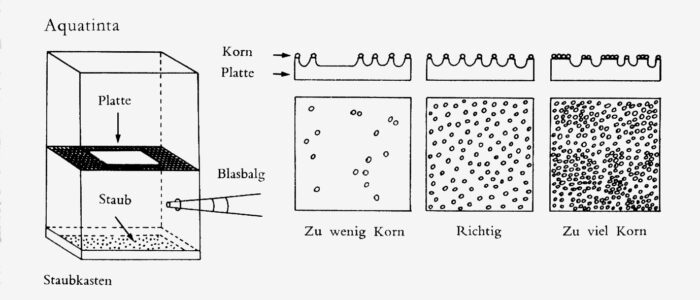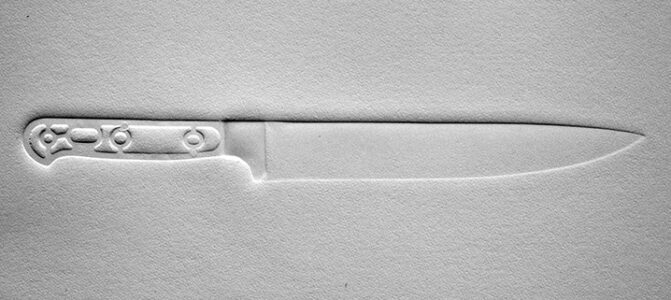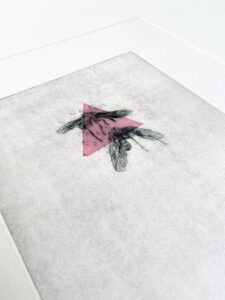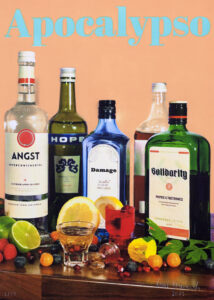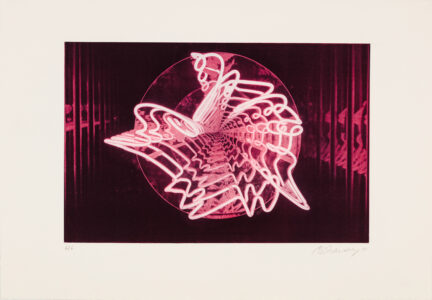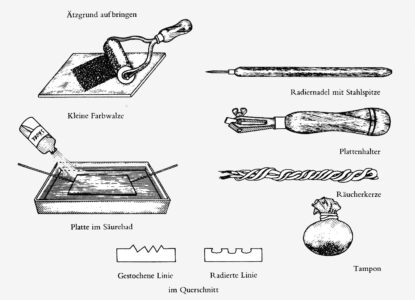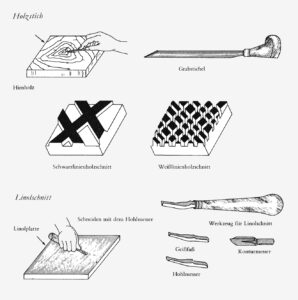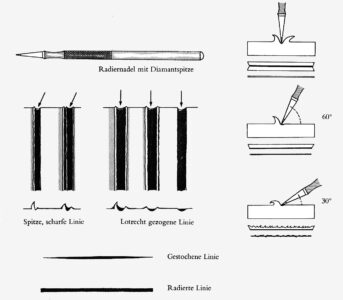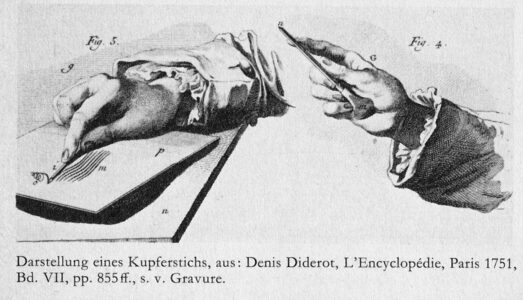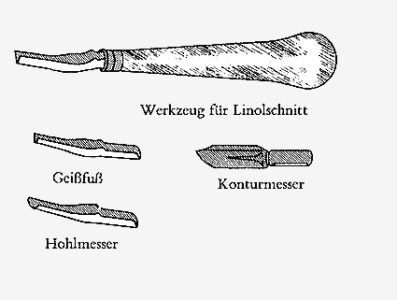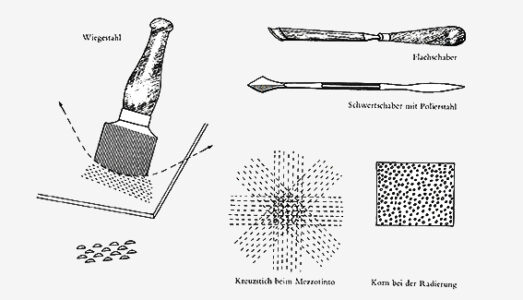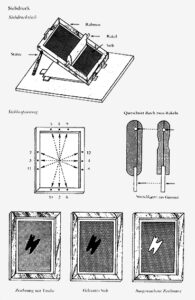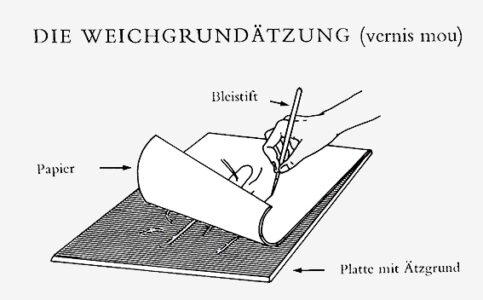Techniques
In our Vienna art printing studio we work with a variety of classical printing techniques. The world of printmaking is fascinating because of its versatility, making it possible to create a wide range of textures and effects – from delicate halftones to striking, deep lines. From bright colors to rich, velvety surfaces.
All prints produced or published by Zein Editions are original artworks in limited editions.
Classic lithography is made with stones. Based on this, the process has been further developed since the 1950s and soon also practiced in art prints.
Alugraphy uses thin aluminum plates with a UV-sensitive layer. The motif is exposed onto the aluminum plate using a strong UV lamp and then fixed to the plate in a chemical bath. After this process, the plate can be inked and printed.
Analog: The motif can be drawn or painted on a transparent foil using various materials such as oil pastels, graphite, lightfast felt-tip pen, acrylic paint or black ink.
Digital: The motif can be digitally separated or broken down into the basic colors or extra layers. The plates are made from these layers.
This planographic printing process is based on the following principle: Exposing the plate creates oleophilic (oil-friendly) and hydrophilic (water-friendly) areas. When the plate is inked, only the oleophilic areas accept the printing ink and thus create the printed image.
The plates are inked by hand and printed color by color or plate by plate in the etching press. The plates must be cleaned and colored again after each process.
Kurt Zein used this technique to develop unique print editions as a specialty of the workshop at the end of the 1980s.
Pulverized asphalt or ground rosin is dusted densely onto a metal plate and the plate is heated from the back. Through the warming this dusty grain melts and sticks to the plate, resulting in thousands of tiny, acid-resistant dots.
The areas of the plate that are not to be etched are protected with liquid etching ground from the acid and, depending on the etching time, these areas result in light to dark tones in the impression, in all shades. These tonal surfaces can be left as they were etched, but it is also possible to work them with a polishing steel, triangular scraper, emery paper, etc., and thus create a wide range of soft transitions (gradients).
AQUATINTA BOX
In this “box” is the above-mentioned Syrian asphalt or powdered rosin. The dust is whirled up by means of a paddle wheel, compressed air, by rotating the box, or whatever. A well-degreased and deoxidized metal plate is now placed in the box, and the dust settles on this plate. If you place the plate in the box immediately after it has been whirled up, only the heavy, coarse dust particles fall on the plate and the aquatint becomes very grainy. If, on the other hand, one waits a while and then inserts the plate, the longer one waits, the finer the grain, which reaches the limit of optical perceptibility. The rest is as described above for aquatint.
With blind embossing, the image is created by materials such as objects or structures that are pressed deep into the paper without being colored.
A sculptural element is inscribed in the medium of prints.
Depending on the incidence of light and the position of the viewer, the imprint changes and can be perceived more subtly or more dynamically.
Adhesive substances are mixed with carborundum (sanding dust). The artist uses it to paint on a metal or plastic plate. After drying, these areas can be colored and printed. The impression on the paper is then raised and rough.
A thin China, Ingres or other colored paper is first glued to the handmade paper to be printed using rice starch. The image from the plate is then printed on it. This glued-on background paper gives the graphic an attractive basic tone, with which one can greatly influence the mood of the sheet. This collage was and is also very often used in photographic high-quality printing techniques.
The motif is digitally separated in an AM grid and separated into different layers. Exposed plates are made from these layers.
The grid is made up of tiny dots of color that blend together to create new hues. The combination of different color dots creates subtle color gradients and nuances that are difficult to achieve with conventional printing processes.
Overall, this technique allows the use of a wide range of colors, including bright and intense hues, to create impressive and vibrant prints with high levels of detail.
This planographic printing process is based on the following principle: Exposing the plate creates oleophilic (oil-friendly) and hydrophilic (water-friendly) areas. When the plate is inked, only the oleophilic areas accept the printing ink and thus create the printed image.
The plates are inked by hand and printed color by color or plate by plate in the etching press. The plates must be cleaned and colored again after each process.
The photogravure is the logical, contemporary, non-toxic further development of the highly toxic classic heliogravure by Karl Klitsch from 1878.
A steel plate coated with light-sensitive polymers is exposed under a non-rastered halftone Diapositive using a strong UV lamp. The image is then disassembled into dots by a further exposure to aquatint film. The point decomposition is so fine that it is barely visible even under a strong magnifying glass.
After exposure, this plate is washed out in various slightly alcoholic water baths. During processing, the darker areas of the image are gradually washed out deeper than the midtones of the highlights.
After careful drying, the plate is subjected to another post-exposure to harden it for the printing process.
The finished plate is inked with oil paint using a hand roller and wiped with netting, fine, smooth paper and the heel of the hand. The process must be repeated for each individual imprint and is the same as with a classic etching.
The plate is then printed onto moistened handmade paper using an etching press.
Lengthy drying of the paint and careful drying and smoothing of the leaves complete the process.
Due to the relief-like application of color – there is more color on the paper in the dark areas than in the mid-tones and the highlights – the sheets have an inimitable charisma. This quality can only be achieved with hand gravure printing.
This is the best known technique and is commonly associated with the term “etching”.
A degreased metal plate is heated and evenly coated with an etching ground consisting of asphalt, beeswax, turpentine, etc. The artist draws through this layer with an etching needle or other tools, exposing the metal. These lines and hatchings are etched deep into the plate with acid. Colored with printing ink, the lines appear as delicate to strong, depending on how long they have been etched, and are raised on the paper.
Unlike line etching, where the drawing is etched into a metal plate with acid, drypoint is a direct process.
The artist scratches his idea into the plate with sharp steel needles of different thicknesses and diamond points, and depending on the vehemence of the procedure, the metal is more or less pushed aside and remains as a “burr” on the plate.
The line has a special character, it does not have the glassy sharpness of the etched material, it allows sensitive artistic possibilities, as well as powerful yet soft, velvety lines that no other etching process offers.
The image to be printed is engraved deep into a copper plate using various gravers. The material is displaced purely mechanically.
There are no tonal gradations, just dots and lines.
The resulting lines have precise and clear edges, parallelism in the strokes or hatching systems and can withstand a very large number of copies.
The technique of engraving is a very labour-intensive type of printmaking that requires a lot of time, strength and skill from the engraver.
The linocut is a graphic technique that works in letterpress and is basically the same as woodcut. As in a woodcut, a negative image is cut into the relatively solid linoleum using special tools. The material is easy to cut in any direction.
The finished negative pattern is overlaid with ink and then printed on paper.
The color adhering to the raised areas is transferred to the paper.
A method of making an intaglio plate in which the surface of the plate is uniformly roughened using rocking motions with a mezzotint knife. If you would ink this area and print it right away, you would get a deep black.
On the roughened plate, the highlights and halftones can now be worked out with a scraper or polishing steel. This means that all tonal values from very light to very dark can be created for a high-contrast light-shadow effect.
The name, monotype = one-time impression, says everything about this technique. The artist paints on a plate with oil or printing inks and this is then printed on handmade paper. This procedure allows very spontaneous, painterly work. The painting action, which cannot be repeated or can only be repeated with difficulty, gives the prints a significant unique character.
Similar to the spitbite etching, acids of different strengths are used to paint directly onto the copper plate. In contrast to the spitbite etching, however, there is no aquatint grain underneath. Accordingly, when printed, the ink does not hold in the etched areas and is more unpredictable and experimental in appearance. The ink often only sticks to the edges of the etched areas and forms patch-like structures.
The artist paints directly on a plate prepared with aquatint with acids of different strengths. This direct work on the record results in extremely lively tonal gradations, from very delicate to powerful.
Soap ground, also called white ground, is—like all grounds—a way of protecting portions of a plate from the acid. Soap, however, is imperfectly acid-resistant. The acid penetrates it in varying degrees depending on its thickness. The artist draws with a paste made of soap flakes, linseed oil, and water. Next, an aquatint is added to provide tooth to the nonimage portions of the plate. The resulting image has tonal gradations, but is essentially white against a dark background.
Silkscreen (also called serigraphy or screenprint) is based on a stencil printing process, one of the oldest graphic principles.
A stencil or template is glued to a silk (or fine nylon) screen and coated with a special emulsion. Today, a photosensitive emulsion is applied and the image is exposed directly onto the screen. Using a squeegee, the color is printed through the open areas in the screen onto the paper underneath.
Screen printing enables bright colors and high ink coverage, which makes it particularly popular to produce posters and textiles.
This is the best known technique and is commonly associated with the term “etching”.
A degreased metal plate is heated and evenly coated with an etching ground consisting of asphalt, beeswax, turpentine, etc. The artist draws through this layer with an etching needle or other tools, exposing the metal. These lines and hatchings are etched deep into the plate with acid. Colored with printing ink, the lines appear as delicate to strong, depending on how long they have been etched, and are raised on the paper.
A heated metal plate is evenly coated with an acid-resistant etching ground that remains sticky. A sheet of rough paper is laid over the prepared plate and the artist draws on it with a pencil.
The sticky ground sticks to the drawn lines on the back of the paper and is lifted off the plate together with the paper. This drawing is then etched into the plate with acid (chemically deepened) and, depending on the roughness of the paper used, produces a pencil, charcoal or pastel-like character in the impression.
The artist paints or draws on a metal plate with a mixture of ink, sugar and gum arabic. Then this painting is covered with a liquid etching ground and, after drying, placed in a water bath. The etching ground does not stick to the areas painted with sugar ink and is washed away by the water, exposing the metal. With or without using the aquatint, these exposed areas are etched.
